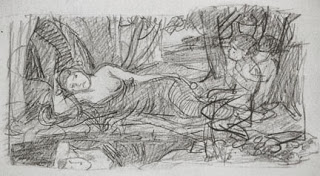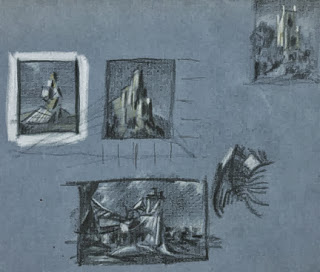While at Garden of the Gods in Colorado Springs, I took a
snapshot of one of the rock formations. The resulting silhouette was almost as
informative as a sunlight photograph and was quite dramatic. An object with a
distinctive shape can gain strength when rendered with a silhouette-like
technique.
Self Portrait, by
Jacek Malczewski, is an unusual and daring use of a near silhouette. The
likeness is more difficult to read, but the effect is quite striking.
Riders on the Beach,
by Max Liebermann, features a very familiar form which doesn’t need much
elaboration to be effective or recognizable.
Flowers in a glass vase, on the other hand, create a more
complex silhouette. Izsak Perlmutter took advantage of that complexity, and
walked a fine line between reality (in the red flowers) and the competing
complexity of the stems, glass and lace curtains. Cyclamen is a masterwork in the still life tradition.
The Charles Bridge, in Prague, has a distinctive look and is
adjacent to several buildings that are recognizable in silhouette. I have seen
many paintings of the same view, but this one, by Alexandr Onishenko, is
perhaps the most dramatic.
Skylines are often distinctive. Most large cities have
groupings of buildings that have become iconic. This painting of Chicago by Ronald Schatz is
one of my favorites.
Amsterdam Bridge
Amsterdam NY by Eric Whiting takes the silhouette to an extreme, but
without sacrificing the information needed to understand the subject. The
combination of abstraction and realism is quite striking.
There are times when you can use a mix of differently toned
silhouettes. This house elevation is a nice combination of dark roof silhouette
and lighter brick wall silhouette. Even if you were to remove the detailing of
windows and doors, you would get a fairly complete sense of the building.
This rendering or the Tom
Ling Son Road Mixed Dev by M. Tamada shows a balance of silhouette and
detail. Like the portrait by Mr. Malczewski above, it is an effect that can be
read both ways. In this case the details show an asymmetric trend, while the
silhouette reinforces the formality of the composition.
Silhouettes may seem obvious, but when you are in the scrum
of rendering a building it is easy to forget that a silhouette can unify a
composition. Toss your unfinished rendering into Photoshop and simplify it with
a filter; you might be surprised by the result.
- Composition Part 17 - Value Studies
A caveat for all posts on composition.
You don’t
want to produce total chaos.
You don’t
want to create banal order.
You do want
to entice, hint, and suggest.
You want to
create mystery, even if the subject appears to be obvious.
- Composition Part 1 - Architectural Illustration
- Composition Part 2 - The Golden Section & other crutches
- Composition Part 3 - Dark Spot
- Composition Part 4 - Light Spot
- Composition Part 5 - The Cross
- Composition Part 6 - The Pyramid
- Composition Part 7 - Circle
- Composition Part 8 - Diagonal
- Composition Part 9 - "L" Frame
- Composition Part 2 - The Golden Section & other crutches
- Composition Part 3 - Dark Spot
- Composition Part 4 - Light Spot
- Composition Part 5 - The Cross
- Composition Part 6 - The Pyramid
- Composition Part 7 - Circle
- Composition Part 8 - Diagonal
- Composition Part 9 - "L" Frame



























































